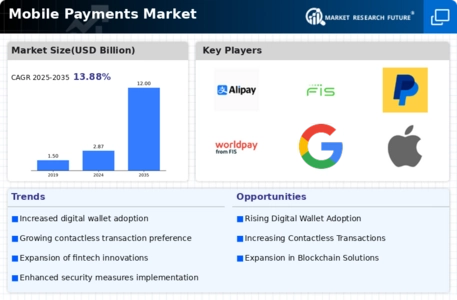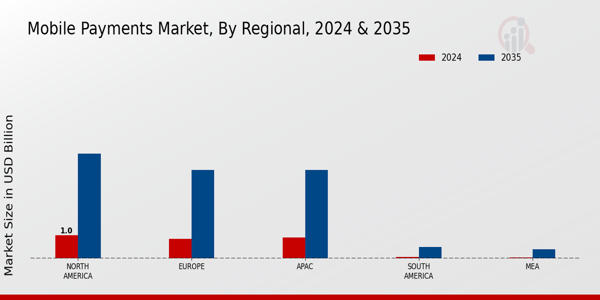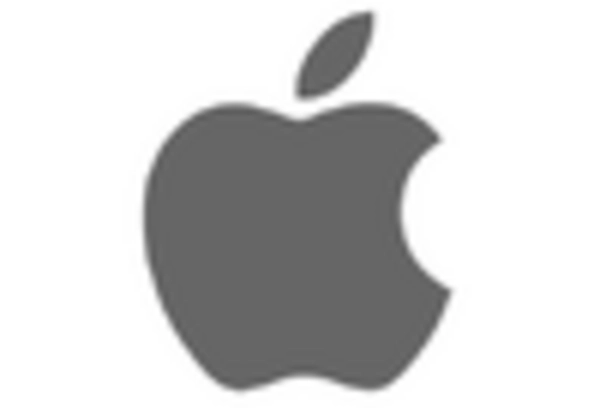-
EXECUTIVE SUMMARY
-
Market Overview
-
Key Findings
-
Market Segmentation
-
Competitive Landscape
-
Challenges and Opportunities
-
Future Outlook
-
MARKET INTRODUCTION
-
Definition
-
Scope of the study
- Research Objective
- Assumption
- Limitations
-
RESEARCH METHODOLOGY
-
Overview
-
Data Mining
-
Secondary Research
-
Primary Research
- Primary Interviews and Information Gathering Process
- Breakdown of Primary Respondents
-
Forecasting Model
-
Market Size Estimation
- Bottom-Up Approach
- Top-Down Approach
-
Data Triangulation
-
Validation
-
MARKET DYNAMICS
-
Overview
-
Drivers
-
Restraints
-
Opportunities
-
MARKET FACTOR ANALYSIS
-
Value chain Analysis
-
Porter's Five Forces Analysis
- Bargaining Power of Suppliers
- Bargaining Power of Buyers
- Threat of New Entrants
- Threat of Substitutes
- Intensity of Rivalry
-
COVID-19 Impact Analysis
- Market Impact Analysis
- Regional Impact
- Opportunity and Threat Analysis
-
MOBILE PAYMENTS MARKET, BY TRANSACTION TYPE (USD BILLION)
-
Remote Payments
-
Proximity Payments
-
In-App Payments
-
Person-to-Person Payments
-
MOBILE PAYMENTS MARKET, BY PAYMENT METHOD (USD BILLION)
-
Credit Cards
-
Debit Cards
-
Mobile Wallets
-
Bank Transfers
-
MOBILE PAYMENTS MARKET, BY END USER (USD BILLION)
-
Retail Consumers
-
Businesses
-
Government
-
MOBILE PAYMENTS MARKET, BY PLATFORM (USD BILLION)
-
Android
-
iOS
-
Web-Based
-
MOBILE PAYMENTS MARKET, BY REGIONAL (USD BILLION)
-
North America
- US
- Canada
-
Europe
- Germany
- UK
- France
- Russia
- Italy
- Spain
- Rest of Europe
-
APAC
- China
- India
- Japan
- South Korea
- Malaysia
- Thailand
- Indonesia
- Rest of APAC
-
South America
- Brazil
- Mexico
- Argentina
- Rest of South America
-
MEA
- GCC Countries
- South Africa
- Rest of MEA
-
COMPETITIVE LANDSCAPE
-
Overview
-
Competitive Analysis
-
Market share Analysis
-
Major Growth Strategy in the Mobile Payments Market
-
Competitive Benchmarking
-
Leading Players in Terms of Number of Developments in the Mobile Payments Market
-
Key developments and growth strategies
- New Product Launch/Service Deployment
- Merger & Acquisitions
- Joint Ventures
-
Major Players Financial Matrix
- Sales and Operating Income
- Major Players R&D Expenditure. 2023
-
COMPANY PROFILES
-
Amazon
- Financial Overview
- Products Offered
- Key Developments
- SWOT Analysis
- Key Strategies
-
Alipay
- Financial Overview
- Products Offered
- Key Developments
- SWOT Analysis
- Key Strategies
-
FIS
- Financial Overview
- Products Offered
- Key Developments
- SWOT Analysis
- Key Strategies
-
PayPal
- Financial Overview
- Products Offered
- Key Developments
- SWOT Analysis
- Key Strategies
-
Worldpay
- Financial Overview
- Products Offered
- Key Developments
- SWOT Analysis
- Key Strategies
-
Google
- Financial Overview
- Products Offered
- Key Developments
- SWOT Analysis
- Key Strategies
-
Apple
- Financial Overview
- Products Offered
- Key Developments
- SWOT Analysis
- Key Strategies
-
WeChat Pay
- Financial Overview
- Products Offered
- Key Developments
- SWOT Analysis
- Key Strategies
-
Stripe
- Financial Overview
- Products Offered
- Key Developments
- SWOT Analysis
- Key Strategies
-
Samsung
- Financial Overview
- Products Offered
- Key Developments
- SWOT Analysis
- Key Strategies
-
Adyen
- Financial Overview
- Products Offered
- Key Developments
- SWOT Analysis
- Key Strategies
-
Square
- Financial Overview
- Products Offered
- Key Developments
- SWOT Analysis
- Key Strategies
-
Visa
- Financial Overview
- Products Offered
- Key Developments
- SWOT Analysis
- Key Strategies
-
Mastercard
- Financial Overview
- Products Offered
- Key Developments
- SWOT Analysis
- Key Strategies
-
Revolut
- Financial Overview
- Products Offered
- Key Developments
- SWOT Analysis
- Key Strategies
-
APPENDIX
-
References
-
Related Reports
-
LIST OF TABLES
-
LIST OF ASSUMPTIONS
-
NORTH AMERICA MOBILE PAYMENTS MARKET SIZE ESTIMATES & FORECAST, BY TRANSACTION TYPE, 2019-2035 (USD BILLIONS)
-
NORTH AMERICA MOBILE PAYMENTS MARKET SIZE ESTIMATES & FORECAST, BY PAYMENT METHOD, 2019-2035 (USD BILLIONS)
-
NORTH AMERICA MOBILE PAYMENTS MARKET SIZE ESTIMATES & FORECAST, BY END USER, 2019-2035 (USD BILLIONS)
-
NORTH AMERICA MOBILE PAYMENTS MARKET SIZE ESTIMATES & FORECAST, BY PLATFORM, 2019-2035 (USD BILLIONS)
-
NORTH AMERICA MOBILE PAYMENTS MARKET SIZE ESTIMATES & FORECAST, BY REGIONAL, 2019-2035 (USD BILLIONS)
-
US MOBILE PAYMENTS MARKET SIZE ESTIMATES & FORECAST, BY TRANSACTION TYPE, 2019-2035 (USD BILLIONS)
-
US MOBILE PAYMENTS MARKET SIZE ESTIMATES & FORECAST, BY PAYMENT METHOD, 2019-2035 (USD BILLIONS)
-
US MOBILE PAYMENTS MARKET SIZE ESTIMATES & FORECAST, BY END USER, 2019-2035 (USD BILLIONS)
-
US MOBILE PAYMENTS MARKET SIZE ESTIMATES & FORECAST, BY PLATFORM, 2019-2035 (USD BILLIONS)
-
US MOBILE PAYMENTS MARKET SIZE ESTIMATES & FORECAST, BY REGIONAL, 2019-2035 (USD BILLIONS)
-
CANADA MOBILE PAYMENTS MARKET SIZE ESTIMATES & FORECAST, BY TRANSACTION TYPE, 2019-2035 (USD BILLIONS)
-
CANADA MOBILE PAYMENTS MARKET SIZE ESTIMATES & FORECAST, BY PAYMENT METHOD, 2019-2035 (USD BILLIONS)
-
CANADA MOBILE PAYMENTS MARKET SIZE ESTIMATES & FORECAST, BY END USER, 2019-2035 (USD BILLIONS)
-
CANADA MOBILE PAYMENTS MARKET SIZE ESTIMATES & FORECAST, BY PLATFORM, 2019-2035 (USD BILLIONS)
-
CANADA MOBILE PAYMENTS MARKET SIZE ESTIMATES & FORECAST, BY REGIONAL, 2019-2035 (USD BILLIONS)
-
EUROPE MOBILE PAYMENTS MARKET SIZE ESTIMATES & FORECAST, BY TRANSACTION TYPE, 2019-2035 (USD BILLIONS)
-
EUROPE MOBILE PAYMENTS MARKET SIZE ESTIMATES & FORECAST, BY PAYMENT METHOD, 2019-2035 (USD BILLIONS)
-
EUROPE MOBILE PAYMENTS MARKET SIZE ESTIMATES & FORECAST, BY END USER, 2019-2035 (USD BILLIONS)
-
EUROPE MOBILE PAYMENTS MARKET SIZE ESTIMATES & FORECAST, BY PLATFORM, 2019-2035 (USD BILLIONS)
-
EUROPE MOBILE PAYMENTS MARKET SIZE ESTIMATES & FORECAST, BY REGIONAL, 2019-2035 (USD BILLIONS)
-
GERMANY MOBILE PAYMENTS MARKET SIZE ESTIMATES & FORECAST, BY TRANSACTION TYPE, 2019-2035 (USD BILLIONS)
-
GERMANY MOBILE PAYMENTS MARKET SIZE ESTIMATES & FORECAST, BY PAYMENT METHOD, 2019-2035 (USD BILLIONS)
-
GERMANY MOBILE PAYMENTS MARKET SIZE ESTIMATES & FORECAST, BY END USER, 2019-2035 (USD BILLIONS)
-
GERMANY MOBILE PAYMENTS MARKET SIZE ESTIMATES & FORECAST, BY PLATFORM, 2019-2035 (USD BILLIONS)
-
GERMANY MOBILE PAYMENTS MARKET SIZE ESTIMATES & FORECAST, BY REGIONAL, 2019-2035 (USD BILLIONS)
-
UK MOBILE PAYMENTS MARKET SIZE ESTIMATES & FORECAST, BY TRANSACTION TYPE, 2019-2035 (USD BILLIONS)
-
UK MOBILE PAYMENTS MARKET SIZE ESTIMATES & FORECAST, BY PAYMENT METHOD, 2019-2035 (USD BILLIONS)
-
UK MOBILE PAYMENTS MARKET SIZE ESTIMATES & FORECAST, BY END USER, 2019-2035 (USD BILLIONS)
-
UK MOBILE PAYMENTS MARKET SIZE ESTIMATES & FORECAST, BY PLATFORM, 2019-2035 (USD BILLIONS)
-
UK MOBILE PAYMENTS MARKET SIZE ESTIMATES & FORECAST, BY REGIONAL, 2019-2035 (USD BILLIONS)
-
FRANCE MOBILE PAYMENTS MARKET SIZE ESTIMATES & FORECAST, BY TRANSACTION TYPE, 2019-2035 (USD BILLIONS)
-
FRANCE MOBILE PAYMENTS MARKET SIZE ESTIMATES & FORECAST, BY PAYMENT METHOD, 2019-2035 (USD BILLIONS)
-
FRANCE MOBILE PAYMENTS MARKET SIZE ESTIMATES & FORECAST, BY END USER, 2019-2035 (USD BILLIONS)
-
FRANCE MOBILE PAYMENTS MARKET SIZE ESTIMATES & FORECAST, BY PLATFORM, 2019-2035 (USD BILLIONS)
-
FRANCE MOBILE PAYMENTS MARKET SIZE ESTIMATES & FORECAST, BY REGIONAL, 2019-2035 (USD BILLIONS)
-
RUSSIA MOBILE PAYMENTS MARKET SIZE ESTIMATES & FORECAST, BY TRANSACTION TYPE, 2019-2035 (USD BILLIONS)
-
RUSSIA MOBILE PAYMENTS MARKET SIZE ESTIMATES & FORECAST, BY PAYMENT METHOD, 2019-2035 (USD BILLIONS)
-
RUSSIA MOBILE PAYMENTS MARKET SIZE ESTIMATES & FORECAST, BY END USER, 2019-2035 (USD BILLIONS)
-
RUSSIA MOBILE PAYMENTS MARKET SIZE ESTIMATES & FORECAST, BY PLATFORM, 2019-2035 (USD BILLIONS)
-
RUSSIA MOBILE PAYMENTS MARKET SIZE ESTIMATES & FORECAST, BY REGIONAL, 2019-2035 (USD BILLIONS)
-
ITALY MOBILE PAYMENTS MARKET SIZE ESTIMATES & FORECAST, BY TRANSACTION TYPE, 2019-2035 (USD BILLIONS)
-
ITALY MOBILE PAYMENTS MARKET SIZE ESTIMATES & FORECAST, BY PAYMENT METHOD, 2019-2035 (USD BILLIONS)
-
ITALY MOBILE PAYMENTS MARKET SIZE ESTIMATES & FORECAST, BY END USER, 2019-2035 (USD BILLIONS)
-
ITALY MOBILE PAYMENTS MARKET SIZE ESTIMATES & FORECAST, BY PLATFORM, 2019-2035 (USD BILLIONS)
-
ITALY MOBILE PAYMENTS MARKET SIZE ESTIMATES & FORECAST, BY REGIONAL, 2019-2035 (USD BILLIONS)
-
SPAIN MOBILE PAYMENTS MARKET SIZE ESTIMATES & FORECAST, BY TRANSACTION TYPE, 2019-2035 (USD BILLIONS)
-
SPAIN MOBILE PAYMENTS MARKET SIZE ESTIMATES & FORECAST, BY PAYMENT METHOD, 2019-2035 (USD BILLIONS)
-
SPAIN MOBILE PAYMENTS MARKET SIZE ESTIMATES & FORECAST, BY END USER, 2019-2035 (USD BILLIONS)
-
SPAIN MOBILE PAYMENTS MARKET SIZE ESTIMATES & FORECAST, BY PLATFORM, 2019-2035 (USD BILLIONS)
-
SPAIN MOBILE PAYMENTS MARKET SIZE ESTIMATES & FORECAST, BY REGIONAL, 2019-2035 (USD BILLIONS)
-
REST OF EUROPE MOBILE PAYMENTS MARKET SIZE ESTIMATES & FORECAST, BY TRANSACTION TYPE, 2019-2035 (USD BILLIONS)
-
REST OF EUROPE MOBILE PAYMENTS MARKET SIZE ESTIMATES & FORECAST, BY PAYMENT METHOD, 2019-2035 (USD BILLIONS)
-
REST OF EUROPE MOBILE PAYMENTS MARKET SIZE ESTIMATES & FORECAST, BY END USER, 2019-2035 (USD BILLIONS)
-
REST OF EUROPE MOBILE PAYMENTS MARKET SIZE ESTIMATES & FORECAST, BY PLATFORM, 2019-2035 (USD BILLIONS)
-
REST OF EUROPE MOBILE PAYMENTS MARKET SIZE ESTIMATES & FORECAST, BY REGIONAL, 2019-2035 (USD BILLIONS)
-
APAC MOBILE PAYMENTS MARKET SIZE ESTIMATES & FORECAST, BY TRANSACTION TYPE, 2019-2035 (USD BILLIONS)
-
APAC MOBILE PAYMENTS MARKET SIZE ESTIMATES & FORECAST, BY PAYMENT METHOD, 2019-2035 (USD BILLIONS)
-
APAC MOBILE PAYMENTS MARKET SIZE ESTIMATES & FORECAST, BY END USER, 2019-2035 (USD BILLIONS)
-
APAC MOBILE PAYMENTS MARKET SIZE ESTIMATES & FORECAST, BY PLATFORM, 2019-2035 (USD BILLIONS)
-
APAC MOBILE PAYMENTS MARKET SIZE ESTIMATES & FORECAST, BY REGIONAL, 2019-2035 (USD BILLIONS)
-
CHINA MOBILE PAYMENTS MARKET SIZE ESTIMATES & FORECAST, BY TRANSACTION TYPE, 2019-2035 (USD BILLIONS)
-
CHINA MOBILE PAYMENTS MARKET SIZE ESTIMATES & FORECAST, BY PAYMENT METHOD, 2019-2035 (USD BILLIONS)
-
CHINA MOBILE PAYMENTS MARKET SIZE ESTIMATES & FORECAST, BY END USER, 2019-2035 (USD BILLIONS)
-
CHINA MOBILE PAYMENTS MARKET SIZE ESTIMATES & FORECAST, BY PLATFORM, 2019-2035 (USD BILLIONS)
-
CHINA MOBILE PAYMENTS MARKET SIZE ESTIMATES & FORECAST, BY REGIONAL, 2019-2035 (USD BILLIONS)
-
INDIA MOBILE PAYMENTS MARKET SIZE ESTIMATES & FORECAST, BY TRANSACTION TYPE, 2019-2035 (USD BILLIONS)
-
INDIA MOBILE PAYMENTS MARKET SIZE ESTIMATES & FORECAST, BY PAYMENT METHOD, 2019-2035 (USD BILLIONS)
-
INDIA MOBILE PAYMENTS MARKET SIZE ESTIMATES & FORECAST, BY END USER, 2019-2035 (USD BILLIONS)
-
INDIA MOBILE PAYMENTS MARKET SIZE ESTIMATES & FORECAST, BY PLATFORM, 2019-2035 (USD BILLIONS)
-
INDIA MOBILE PAYMENTS MARKET SIZE ESTIMATES & FORECAST, BY REGIONAL, 2019-2035 (USD BILLIONS)
-
JAPAN MOBILE PAYMENTS MARKET SIZE ESTIMATES & FORECAST, BY TRANSACTION TYPE, 2019-2035 (USD BILLIONS)
-
JAPAN MOBILE PAYMENTS MARKET SIZE ESTIMATES & FORECAST, BY PAYMENT METHOD, 2019-2035 (USD BILLIONS)
-
JAPAN MOBILE PAYMENTS MARKET SIZE ESTIMATES & FORECAST, BY END USER, 2019-2035 (USD BILLIONS)
-
JAPAN MOBILE PAYMENTS MARKET SIZE ESTIMATES & FORECAST, BY PLATFORM, 2019-2035 (USD BILLIONS)
-
JAPAN MOBILE PAYMENTS MARKET SIZE ESTIMATES & FORECAST, BY REGIONAL, 2019-2035 (USD BILLIONS)
-
SOUTH KOREA MOBILE PAYMENTS MARKET SIZE ESTIMATES & FORECAST, BY TRANSACTION TYPE, 2019-2035 (USD BILLIONS)
-
SOUTH KOREA MOBILE PAYMENTS MARKET SIZE ESTIMATES & FORECAST, BY PAYMENT METHOD, 2019-2035 (USD BILLIONS)
-
SOUTH KOREA MOBILE PAYMENTS MARKET SIZE ESTIMATES & FORECAST, BY END USER, 2019-2035 (USD BILLIONS)
-
SOUTH KOREA MOBILE PAYMENTS MARKET SIZE ESTIMATES & FORECAST, BY PLATFORM, 2019-2035 (USD BILLIONS)
-
SOUTH KOREA MOBILE PAYMENTS MARKET SIZE ESTIMATES & FORECAST, BY REGIONAL, 2019-2035 (USD BILLIONS)
-
MALAYSIA MOBILE PAYMENTS MARKET SIZE ESTIMATES & FORECAST, BY TRANSACTION TYPE, 2019-2035 (USD BILLIONS)
-
MALAYSIA MOBILE PAYMENTS MARKET SIZE ESTIMATES & FORECAST, BY PAYMENT METHOD, 2019-2035 (USD BILLIONS)
-
MALAYSIA MOBILE PAYMENTS MARKET SIZE ESTIMATES & FORECAST, BY END USER, 2019-2035 (USD BILLIONS)
-
MALAYSIA MOBILE PAYMENTS MARKET SIZE ESTIMATES & FORECAST, BY PLATFORM, 2019-2035 (USD BILLIONS)
-
MALAYSIA MOBILE PAYMENTS MARKET SIZE ESTIMATES & FORECAST, BY REGIONAL, 2019-2035 (USD BILLIONS)
-
THAILAND MOBILE PAYMENTS MARKET SIZE ESTIMATES & FORECAST, BY TRANSACTION TYPE, 2019-2035 (USD BILLIONS)
-
THAILAND MOBILE PAYMENTS MARKET SIZE ESTIMATES & FORECAST, BY PAYMENT METHOD, 2019-2035 (USD BILLIONS)
-
THAILAND MOBILE PAYMENTS MARKET SIZE ESTIMATES & FORECAST, BY END USER, 2019-2035 (USD BILLIONS)
-
THAILAND MOBILE PAYMENTS MARKET SIZE ESTIMATES & FORECAST, BY PLATFORM, 2019-2035 (USD BILLIONS)
-
THAILAND MOBILE PAYMENTS MARKET SIZE ESTIMATES & FORECAST, BY REGIONAL, 2019-2035 (USD BILLIONS)
-
INDONESIA MOBILE PAYMENTS MARKET SIZE ESTIMATES & FORECAST, BY TRANSACTION TYPE, 2019-2035 (USD BILLIONS)
-
INDONESIA MOBILE PAYMENTS MARKET SIZE ESTIMATES & FORECAST, BY PAYMENT METHOD, 2019-2035 (USD BILLIONS)
-
INDONESIA MOBILE PAYMENTS MARKET SIZE ESTIMATES & FORECAST, BY END USER, 2019-2035 (USD BILLIONS)
-
INDONESIA MOBILE PAYMENTS MARKET SIZE ESTIMATES & FORECAST, BY PLATFORM, 2019-2035 (USD BILLIONS)
-
INDONESIA MOBILE PAYMENTS MARKET SIZE ESTIMATES & FORECAST, BY REGIONAL, 2019-2035 (USD BILLIONS)
-
REST OF APAC MOBILE PAYMENTS MARKET SIZE ESTIMATES & FORECAST, BY TRANSACTION TYPE, 2019-2035 (USD BILLIONS)
-
REST OF APAC MOBILE PAYMENTS MARKET SIZE ESTIMATES & FORECAST, BY PAYMENT METHOD, 2019-2035 (USD BILLIONS)
-
REST OF APAC MOBILE PAYMENTS MARKET SIZE ESTIMATES & FORECAST, BY END USER, 2019-2035 (USD BILLIONS)
-
REST OF APAC MOBILE PAYMENTS MARKET SIZE ESTIMATES & FORECAST, BY PLATFORM, 2019-2035 (USD BILLIONS)
-
REST OF APAC MOBILE PAYMENTS MARKET SIZE ESTIMATES & FORECAST, BY REGIONAL, 2019-2035 (USD BILLIONS)
-
SOUTH AMERICA MOBILE PAYMENTS MARKET SIZE ESTIMATES & FORECAST, BY TRANSACTION TYPE, 2019-2035 (USD BILLIONS)
-
SOUTH AMERICA MOBILE PAYMENTS MARKET SIZE ESTIMATES & FORECAST, BY PAYMENT METHOD, 2019-2035 (USD BILLIONS)
-
SOUTH AMERICA MOBILE PAYMENTS MARKET SIZE ESTIMATES & FORECAST, BY END USER, 2019-2035 (USD BILLIONS)
-
SOUTH AMERICA MOBILE PAYMENTS MARKET SIZE ESTIMATES & FORECAST, BY PLATFORM, 2019-2035 (USD BILLIONS)
-
SOUTH AMERICA MOBILE PAYMENTS MARKET SIZE ESTIMATES & FORECAST, BY REGIONAL, 2019-2035 (USD BILLIONS)
-
BRAZIL MOBILE PAYMENTS MARKET SIZE ESTIMATES & FORECAST, BY TRANSACTION TYPE, 2019-2035 (USD BILLIONS)
-
BRAZIL MOBILE PAYMENTS MARKET SIZE ESTIMATES & FORECAST, BY PAYMENT METHOD, 2019-2035 (USD BILLIONS)
-
BRAZIL MOBILE PAYMENTS MARKET SIZE ESTIMATES & FORECAST, BY END USER, 2019-2035 (USD BILLIONS)
-
BRAZIL MOBILE PAYMENTS MARKET SIZE ESTIMATES & FORECAST, BY PLATFORM, 2019-2035 (USD BILLIONS)
-
BRAZIL MOBILE PAYMENTS MARKET SIZE ESTIMATES & FORECAST, BY REGIONAL, 2019-2035 (USD BILLIONS)
-
MEXICO MOBILE PAYMENTS MARKET SIZE ESTIMATES & FORECAST, BY TRANSACTION TYPE, 2019-2035 (USD BILLIONS)
-
MEXICO MOBILE PAYMENTS MARKET SIZE ESTIMATES & FORECAST, BY PAYMENT METHOD, 2019-2035 (USD BILLIONS)
-
MEXICO MOBILE PAYMENTS MARKET SIZE ESTIMATES & FORECAST, BY END USER, 2019-2035 (USD BILLIONS)
-
MEXICO MOBILE PAYMENTS MARKET SIZE ESTIMATES & FORECAST, BY PLATFORM, 2019-2035 (USD BILLIONS)
-
MEXICO MOBILE PAYMENTS MARKET SIZE ESTIMATES & FORECAST, BY REGIONAL, 2019-2035 (USD BILLIONS)
-
ARGENTINA MOBILE PAYMENTS MARKET SIZE ESTIMATES & FORECAST, BY TRANSACTION TYPE, 2019-2035 (USD BILLIONS)
-
ARGENTINA MOBILE PAYMENTS MARKET SIZE ESTIMATES & FORECAST, BY PAYMENT METHOD, 2019-2035 (USD BILLIONS)
-
ARGENTINA MOBILE PAYMENTS MARKET SIZE ESTIMATES & FORECAST, BY END USER, 2019-2035 (USD BILLIONS)
-
ARGENTINA MOBILE PAYMENTS MARKET SIZE ESTIMATES & FORECAST, BY PLATFORM, 2019-2035 (USD BILLIONS)
-
ARGENTINA MOBILE PAYMENTS MARKET SIZE ESTIMATES & FORECAST, BY REGIONAL, 2019-2035 (USD BILLIONS)
-
REST OF SOUTH AMERICA MOBILE PAYMENTS MARKET SIZE ESTIMATES & FORECAST, BY TRANSACTION TYPE, 2019-2035 (USD BILLIONS)
-
REST OF SOUTH AMERICA MOBILE PAYMENTS MARKET SIZE ESTIMATES & FORECAST, BY PAYMENT METHOD, 2019-2035 (USD BILLIONS)
-
REST OF SOUTH AMERICA MOBILE PAYMENTS MARKET SIZE ESTIMATES & FORECAST, BY END USER, 2019-2035 (USD BILLIONS)
-
REST OF SOUTH AMERICA MOBILE PAYMENTS MARKET SIZE ESTIMATES & FORECAST, BY PLATFORM, 2019-2035 (USD BILLIONS)
-
REST OF SOUTH AMERICA MOBILE PAYMENTS MARKET SIZE ESTIMATES & FORECAST, BY REGIONAL, 2019-2035 (USD BILLIONS)
-
MEA MOBILE PAYMENTS MARKET SIZE ESTIMATES & FORECAST, BY TRANSACTION TYPE, 2019-2035 (USD BILLIONS)
-
MEA MOBILE PAYMENTS MARKET SIZE ESTIMATES & FORECAST, BY PAYMENT METHOD, 2019-2035 (USD BILLIONS)
-
MEA MOBILE PAYMENTS MARKET SIZE ESTIMATES & FORECAST, BY END USER, 2019-2035 (USD BILLIONS)
-
MEA MOBILE PAYMENTS MARKET SIZE ESTIMATES & FORECAST, BY PLATFORM, 2019-2035 (USD BILLIONS)
-
MEA MOBILE PAYMENTS MARKET SIZE ESTIMATES & FORECAST, BY REGIONAL, 2019-2035 (USD BILLIONS)
-
GCC COUNTRIES MOBILE PAYMENTS MARKET SIZE ESTIMATES & FORECAST, BY TRANSACTION TYPE, 2019-2035 (USD BILLIONS)
-
GCC COUNTRIES MOBILE PAYMENTS MARKET SIZE ESTIMATES & FORECAST, BY PAYMENT METHOD, 2019-2035 (USD BILLIONS)
-
GCC COUNTRIES MOBILE PAYMENTS MARKET SIZE ESTIMATES & FORECAST, BY END USER, 2019-2035 (USD BILLIONS)
-
GCC COUNTRIES MOBILE PAYMENTS MARKET SIZE ESTIMATES & FORECAST, BY PLATFORM, 2019-2035 (USD BILLIONS)
-
GCC COUNTRIES MOBILE PAYMENTS MARKET SIZE ESTIMATES & FORECAST, BY REGIONAL, 2019-2035 (USD BILLIONS)
-
SOUTH AFRICA MOBILE PAYMENTS MARKET SIZE ESTIMATES & FORECAST, BY TRANSACTION TYPE, 2019-2035 (USD BILLIONS)
-
SOUTH AFRICA MOBILE PAYMENTS MARKET SIZE ESTIMATES & FORECAST, BY PAYMENT METHOD, 2019-2035 (USD BILLIONS)
-
SOUTH AFRICA MOBILE PAYMENTS MARKET SIZE ESTIMATES & FORECAST, BY END USER, 2019-2035 (USD BILLIONS)
-
SOUTH AFRICA MOBILE PAYMENTS MARKET SIZE ESTIMATES & FORECAST, BY PLATFORM, 2019-2035 (USD BILLIONS)
-
SOUTH AFRICA MOBILE PAYMENTS MARKET SIZE ESTIMATES & FORECAST, BY REGIONAL, 2019-2035 (USD BILLIONS)
-
REST OF MEA MOBILE PAYMENTS MARKET SIZE ESTIMATES & FORECAST, BY TRANSACTION TYPE, 2019-2035 (USD BILLIONS)
-
REST OF MEA MOBILE PAYMENTS MARKET SIZE ESTIMATES & FORECAST, BY PAYMENT METHOD, 2019-2035 (USD BILLIONS)
-
REST OF MEA MOBILE PAYMENTS MARKET SIZE ESTIMATES & FORECAST, BY END USER, 2019-2035 (USD BILLIONS)
-
REST OF MEA MOBILE PAYMENTS MARKET SIZE ESTIMATES & FORECAST, BY PLATFORM, 2019-2035 (USD BILLIONS)
-
REST OF MEA MOBILE PAYMENTS MARKET SIZE ESTIMATES & FORECAST, BY REGIONAL, 2019-2035 (USD BILLIONS)
-
PRODUCT LAUNCH/PRODUCT DEVELOPMENT/APPROVAL
-
ACQUISITION/PARTNERSHIP
-
LIST OF FIGURES
-
MARKET SYNOPSIS
-
NORTH AMERICA MOBILE PAYMENTS MARKET ANALYSIS
-
US MOBILE PAYMENTS MARKET ANALYSIS BY TRANSACTION TYPE
-
US MOBILE PAYMENTS MARKET ANALYSIS BY PAYMENT METHOD
-
US MOBILE PAYMENTS MARKET ANALYSIS BY END USER
-
US MOBILE PAYMENTS MARKET ANALYSIS BY PLATFORM
-
US MOBILE PAYMENTS MARKET ANALYSIS BY REGIONAL
-
CANADA MOBILE PAYMENTS MARKET ANALYSIS BY TRANSACTION TYPE
-
CANADA MOBILE PAYMENTS MARKET ANALYSIS BY PAYMENT METHOD
-
CANADA MOBILE PAYMENTS MARKET ANALYSIS BY END USER
-
CANADA MOBILE PAYMENTS MARKET ANALYSIS BY PLATFORM
-
CANADA MOBILE PAYMENTS MARKET ANALYSIS BY REGIONAL
-
EUROPE MOBILE PAYMENTS MARKET ANALYSIS
-
GERMANY MOBILE PAYMENTS MARKET ANALYSIS BY TRANSACTION TYPE
-
GERMANY MOBILE PAYMENTS MARKET ANALYSIS BY PAYMENT METHOD
-
GERMANY MOBILE PAYMENTS MARKET ANALYSIS BY END USER
-
GERMANY MOBILE PAYMENTS MARKET ANALYSIS BY PLATFORM
-
GERMANY MOBILE PAYMENTS MARKET ANALYSIS BY REGIONAL
-
UK MOBILE PAYMENTS MARKET ANALYSIS BY TRANSACTION TYPE
-
UK MOBILE PAYMENTS MARKET ANALYSIS BY PAYMENT METHOD
-
UK MOBILE PAYMENTS MARKET ANALYSIS BY END USER
-
UK MOBILE PAYMENTS MARKET ANALYSIS BY PLATFORM
-
UK MOBILE PAYMENTS MARKET ANALYSIS BY REGIONAL
-
FRANCE MOBILE PAYMENTS MARKET ANALYSIS BY TRANSACTION TYPE
-
FRANCE MOBILE PAYMENTS MARKET ANALYSIS BY PAYMENT METHOD
-
FRANCE MOBILE PAYMENTS MARKET ANALYSIS BY END USER
-
FRANCE MOBILE PAYMENTS MARKET ANALYSIS BY PLATFORM
-
FRANCE MOBILE PAYMENTS MARKET ANALYSIS BY REGIONAL
-
RUSSIA MOBILE PAYMENTS MARKET ANALYSIS BY TRANSACTION TYPE
-
RUSSIA MOBILE PAYMENTS MARKET ANALYSIS BY PAYMENT METHOD
-
RUSSIA MOBILE PAYMENTS MARKET ANALYSIS BY END USER
-
RUSSIA MOBILE PAYMENTS MARKET ANALYSIS BY PLATFORM
-
RUSSIA MOBILE PAYMENTS MARKET ANALYSIS BY REGIONAL
-
ITALY MOBILE PAYMENTS MARKET ANALYSIS BY TRANSACTION TYPE
-
ITALY MOBILE PAYMENTS MARKET ANALYSIS BY PAYMENT METHOD
-
ITALY MOBILE PAYMENTS MARKET ANALYSIS BY END USER
-
ITALY MOBILE PAYMENTS MARKET ANALYSIS BY PLATFORM
-
ITALY MOBILE PAYMENTS MARKET ANALYSIS BY REGIONAL
-
SPAIN MOBILE PAYMENTS MARKET ANALYSIS BY TRANSACTION TYPE
-
SPAIN MOBILE PAYMENTS MARKET ANALYSIS BY PAYMENT METHOD
-
SPAIN MOBILE PAYMENTS MARKET ANALYSIS BY END USER
-
SPAIN MOBILE PAYMENTS MARKET ANALYSIS BY PLATFORM
-
SPAIN MOBILE PAYMENTS MARKET ANALYSIS BY REGIONAL
-
REST OF EUROPE MOBILE PAYMENTS MARKET ANALYSIS BY TRANSACTION TYPE
-
REST OF EUROPE MOBILE PAYMENTS MARKET ANALYSIS BY PAYMENT METHOD
-
REST OF EUROPE MOBILE PAYMENTS MARKET ANALYSIS BY END USER
-
REST OF EUROPE MOBILE PAYMENTS MARKET ANALYSIS BY PLATFORM
-
REST OF EUROPE MOBILE PAYMENTS MARKET ANALYSIS BY REGIONAL
-
APAC MOBILE PAYMENTS MARKET ANALYSIS
-
CHINA MOBILE PAYMENTS MARKET ANALYSIS BY TRANSACTION TYPE
-
CHINA MOBILE PAYMENTS MARKET ANALYSIS BY PAYMENT METHOD
-
CHINA MOBILE PAYMENTS MARKET ANALYSIS BY END USER
-
CHINA MOBILE PAYMENTS MARKET ANALYSIS BY PLATFORM
-
CHINA MOBILE PAYMENTS MARKET ANALYSIS BY REGIONAL
-
INDIA MOBILE PAYMENTS MARKET ANALYSIS BY TRANSACTION TYPE
-
INDIA MOBILE PAYMENTS MARKET ANALYSIS BY PAYMENT METHOD
-
INDIA MOBILE PAYMENTS MARKET ANALYSIS BY END USER
-
INDIA MOBILE PAYMENTS MARKET ANALYSIS BY PLATFORM
-
INDIA MOBILE PAYMENTS MARKET ANALYSIS BY REGIONAL
-
JAPAN MOBILE PAYMENTS MARKET ANALYSIS BY TRANSACTION TYPE
-
JAPAN MOBILE PAYMENTS MARKET ANALYSIS BY PAYMENT METHOD
-
JAPAN MOBILE PAYMENTS MARKET ANALYSIS BY END USER
-
JAPAN MOBILE PAYMENTS MARKET ANALYSIS BY PLATFORM
-
JAPAN MOBILE PAYMENTS MARKET ANALYSIS BY REGIONAL
-
SOUTH KOREA MOBILE PAYMENTS MARKET ANALYSIS BY TRANSACTION TYPE
-
SOUTH KOREA MOBILE PAYMENTS MARKET ANALYSIS BY PAYMENT METHOD
-
SOUTH KOREA MOBILE PAYMENTS MARKET ANALYSIS BY END USER
-
SOUTH KOREA MOBILE PAYMENTS MARKET ANALYSIS BY PLATFORM
-
SOUTH KOREA MOBILE PAYMENTS MARKET ANALYSIS BY REGIONAL
-
MALAYSIA MOBILE PAYMENTS MARKET ANALYSIS BY TRANSACTION TYPE
-
MALAYSIA MOBILE PAYMENTS MARKET ANALYSIS BY PAYMENT METHOD
-
MALAYSIA MOBILE PAYMENTS MARKET ANALYSIS BY END USER
-
MALAYSIA MOBILE PAYMENTS MARKET ANALYSIS BY PLATFORM
-
MALAYSIA MOBILE PAYMENTS MARKET ANALYSIS BY REGIONAL
-
THAILAND MOBILE PAYMENTS MARKET ANALYSIS BY TRANSACTION TYPE
-
THAILAND MOBILE PAYMENTS MARKET ANALYSIS BY PAYMENT METHOD
-
THAILAND MOBILE PAYMENTS MARKET ANALYSIS BY END USER
-
THAILAND MOBILE PAYMENTS MARKET ANALYSIS BY PLATFORM
-
THAILAND MOBILE PAYMENTS MARKET ANALYSIS BY REGIONAL
-
INDONESIA MOBILE PAYMENTS MARKET ANALYSIS BY TRANSACTION TYPE
-
INDONESIA MOBILE PAYMENTS MARKET ANALYSIS BY PAYMENT METHOD
-
INDONESIA MOBILE PAYMENTS MARKET ANALYSIS BY END USER
-
INDONESIA MOBILE PAYMENTS MARKET ANALYSIS BY PLATFORM
-
INDONESIA MOBILE PAYMENTS MARKET ANALYSIS BY REGIONAL
-
REST OF APAC MOBILE PAYMENTS MARKET ANALYSIS BY TRANSACTION TYPE
-
REST OF APAC MOBILE PAYMENTS MARKET ANALYSIS BY PAYMENT METHOD
-
REST OF APAC MOBILE PAYMENTS MARKET ANALYSIS BY END USER
-
REST OF APAC MOBILE PAYMENTS MARKET ANALYSIS BY PLATFORM
-
REST OF APAC MOBILE PAYMENTS MARKET ANALYSIS BY REGIONAL
-
SOUTH AMERICA MOBILE PAYMENTS MARKET ANALYSIS
-
BRAZIL MOBILE PAYMENTS MARKET ANALYSIS BY TRANSACTION TYPE
-
BRAZIL MOBILE PAYMENTS MARKET ANALYSIS BY PAYMENT METHOD
-
BRAZIL MOBILE PAYMENTS MARKET ANALYSIS BY END USER
-
BRAZIL MOBILE PAYMENTS MARKET ANALYSIS BY PLATFORM
-
BRAZIL MOBILE PAYMENTS MARKET ANALYSIS BY REGIONAL
-
MEXICO MOBILE PAYMENTS MARKET ANALYSIS BY TRANSACTION TYPE
-
MEXICO MOBILE PAYMENTS MARKET ANALYSIS BY PAYMENT METHOD
-
MEXICO MOBILE PAYMENTS MARKET ANALYSIS BY END USER
-
MEXICO MOBILE PAYMENTS MARKET ANALYSIS BY PLATFORM
-
MEXICO MOBILE PAYMENTS MARKET ANALYSIS BY REGIONAL
-
ARGENTINA MOBILE PAYMENTS MARKET ANALYSIS BY TRANSACTION TYPE
-
ARGENTINA MOBILE PAYMENTS MARKET ANALYSIS BY PAYMENT METHOD
-
ARGENTINA MOBILE PAYMENTS MARKET ANALYSIS BY END USER
-
ARGENTINA MOBILE PAYMENTS MARKET ANALYSIS BY PLATFORM
-
ARGENTINA MOBILE PAYMENTS MARKET ANALYSIS BY REGIONAL
-
REST OF SOUTH AMERICA MOBILE PAYMENTS MARKET ANALYSIS BY TRANSACTION TYPE
-
REST OF SOUTH AMERICA MOBILE PAYMENTS MARKET ANALYSIS BY PAYMENT METHOD
-
REST OF SOUTH AMERICA MOBILE PAYMENTS MARKET ANALYSIS BY END USER
-
REST OF SOUTH AMERICA MOBILE PAYMENTS MARKET ANALYSIS BY PLATFORM
-
REST OF SOUTH AMERICA MOBILE PAYMENTS MARKET ANALYSIS BY REGIONAL
-
MEA MOBILE PAYMENTS MARKET ANALYSIS
-
GCC COUNTRIES MOBILE PAYMENTS MARKET ANALYSIS BY TRANSACTION TYPE
-
GCC COUNTRIES MOBILE PAYMENTS MARKET ANALYSIS BY PAYMENT METHOD
-
GCC COUNTRIES MOBILE PAYMENTS MARKET ANALYSIS BY END USER
-
GCC COUNTRIES MOBILE PAYMENTS MARKET ANALYSIS BY PLATFORM
-
GCC COUNTRIES MOBILE PAYMENTS MARKET ANALYSIS BY REGIONAL
-
SOUTH AFRICA MOBILE PAYMENTS MARKET ANALYSIS BY TRANSACTION TYPE
-
SOUTH AFRICA MOBILE PAYMENTS MARKET ANALYSIS BY PAYMENT METHOD
-
SOUTH AFRICA MOBILE PAYMENTS MARKET ANALYSIS BY END USER
-
SOUTH AFRICA MOBILE PAYMENTS MARKET ANALYSIS BY PLATFORM
-
SOUTH AFRICA MOBILE PAYMENTS MARKET ANALYSIS BY REGIONAL
-
REST OF MEA MOBILE PAYMENTS MARKET ANALYSIS BY TRANSACTION TYPE
-
REST OF MEA MOBILE PAYMENTS MARKET ANALYSIS BY PAYMENT METHOD
-
REST OF MEA MOBILE PAYMENTS MARKET ANALYSIS BY END USER
-
REST OF MEA MOBILE PAYMENTS MARKET ANALYSIS BY PLATFORM
-
REST OF MEA MOBILE PAYMENTS MARKET ANALYSIS BY REGIONAL
-
KEY BUYING CRITERIA OF MOBILE PAYMENTS MARKET
-
RESEARCH PROCESS OF MRFR
-
DRO ANALYSIS OF MOBILE PAYMENTS MARKET
-
DRIVERS IMPACT ANALYSIS: MOBILE PAYMENTS MARKET
-
RESTRAINTS IMPACT ANALYSIS: MOBILE PAYMENTS MARKET
-
SUPPLY / VALUE CHAIN: MOBILE PAYMENTS MARKET
-
MOBILE PAYMENTS MARKET, BY TRANSACTION TYPE, 2025 (% SHARE)
-
MOBILE PAYMENTS MARKET, BY TRANSACTION TYPE, 2019 TO 2035 (USD Billions)
-
MOBILE PAYMENTS MARKET, BY PAYMENT METHOD, 2025 (% SHARE)
-
MOBILE PAYMENTS MARKET, BY PAYMENT METHOD, 2019 TO 2035 (USD Billions)
-
MOBILE PAYMENTS MARKET, BY END USER, 2025 (% SHARE)
-
MOBILE PAYMENTS MARKET, BY END USER, 2019 TO 2035 (USD Billions)
-
MOBILE PAYMENTS MARKET, BY PLATFORM, 2025 (% SHARE)
-
MOBILE PAYMENTS MARKET, BY PLATFORM, 2019 TO 2035 (USD Billions)
-
MOBILE PAYMENTS MARKET, BY REGIONAL, 2025 (% SHARE)
-
MOBILE PAYMENTS MARKET, BY REGIONAL, 2019 TO 2035 (USD Billions)
-
BENCHMARKING OF MAJOR COMPETITORS










Leave a Comment